History of the medieval village of La Garde-Guerin |

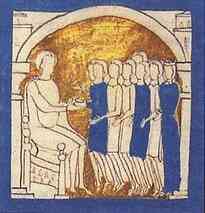 In the 11th century, a garrison was established in the village, creating a sort of police responsible for ensuring the safety of travelers. To finance this, certain taxes were collected, including tolls (on all goods or travelers passing through), guidance fees (for the protection of travelers and goods), measurement fees (on foodstuffs measured by the cart), dust fees (when herds stirred up dust!), and many other charges.
In the 11th century, a garrison was established in the village, creating a sort of police responsible for ensuring the safety of travelers. To finance this, certain taxes were collected, including tolls (on all goods or travelers passing through), guidance fees (for the protection of travelers and goods), measurement fees (on foodstuffs measured by the cart), dust fees (when herds stirred up dust!), and many other charges.
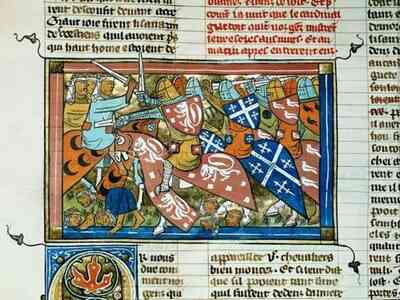 Subsequently, La Garde-Guerin established a secular vassal system, organized according to the masters of chivalric schools and promoting equality of rights and duties for all. This phenomenon was unusual in France at that time, but it was never equaled and transformed into "Chevaliers pariers" (so named because they were equal in rights). Although Aldebert III (Bishop of Mende) could not even know what had happened there, after several attempts, in 1163, he succeeded in besieging La Garde, leading a group of nobles he had convinced of the excessive cost of tolls and the unjust behavior of the "Chevaliers pariers". Subsequently, La Garde was entrusted to the Guerin family from Tournel, hence the name La Garde-Guerin. The "Chevaliers pariers" shared the lordship and each owned a house with a well. The houses were separated by very narrow "streets" (about 12 inches wide!) called "Pans du Roi"; this served to delineate their properties, thus creating independence where "everyone had to look after their own affairs".
Subsequently, La Garde-Guerin established a secular vassal system, organized according to the masters of chivalric schools and promoting equality of rights and duties for all. This phenomenon was unusual in France at that time, but it was never equaled and transformed into "Chevaliers pariers" (so named because they were equal in rights). Although Aldebert III (Bishop of Mende) could not even know what had happened there, after several attempts, in 1163, he succeeded in besieging La Garde, leading a group of nobles he had convinced of the excessive cost of tolls and the unjust behavior of the "Chevaliers pariers". Subsequently, La Garde was entrusted to the Guerin family from Tournel, hence the name La Garde-Guerin. The "Chevaliers pariers" shared the lordship and each owned a house with a well. The houses were separated by very narrow "streets" (about 12 inches wide!) called "Pans du Roi"; this served to delineate their properties, thus creating independence where "everyone had to look after their own affairs".
In 1258, 31 properties were recorded. Even today, it is still possible to see the same 31 houses! From 1260, the "Chevaliers pariers" elected two of their own each year, swearing an oath before the bishop. They were responsible for the distribution of revenues and the maintenance of the path. In 1367, Louis of Anjou, Count of Maine and the second son of the King of France, instituted a three-day fair for Saint Catherine (on November 25) and a market on Mondays. In 1721, this fair was moved to September 29 (Saint Michael's Day, the village's patron saint).
In the 16th century, the Bishop of Mende, Renaud de Beaume, sold his shares in the village to the lord of Morangies, who then held the majority. At the end of the 16th century, during the Wars of Religion, the castle and the village were burned down. The village was immediately rebuilt by the heirs of the "Chevaliers Pariers". Its Renaissance style is called "Regordanien", linked to the Regordane Way and certain architectural features, such as the carriage entrances visible in the church street in Villefort and in other villages located along the Regordane Way. In 1722, the castle was again burned down due to the negligence of a farmer. This happened because the owners preferred to go to Versailles and left the castle to farmers who did not take care of it.
All old rights and charges were eventually abolished during the French Revolution of 1789. In 1795, while the castle lay in ruins due to the fire, one of the towers collapsed onto a house, killing most of the inhabitants. The construction of the current road began in 1840. The Regordane Way was then no longer used except as a transhumance path, to move animals to seasonal pastures. In 1929, the castle, donjon, and church were classified as Historical Monuments and the village became a registered site. In 1992, La Garde-Guerin received the label as one of the most beautiful villages in France.
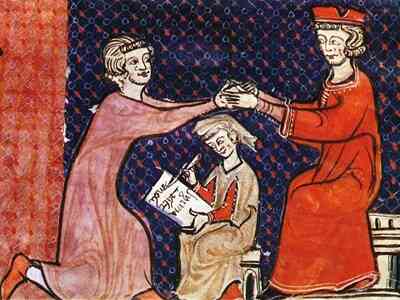 The church, believed to date from the 12th century, is of Provençal Romanesque style and dedicated to Saint Michael. The barrel vault is made of cut stone. The crossing of the nave and the apse is supported by a double projecting arch built on pillars. The capitals are all different, sometimes carved with motifs of leaves, flowers, or animals, sometimes with enigmatic biblical figures. The tops of the columns are often adorned with a checkered motif. The choir is decorated with harmonious arches with small columns or simple capitals. Two stained glass windows allow light to enter. Beneath the choir, a small tomb carved into the rock houses the Consuls of the "Pariers" of La Garde. The portal consists of three molded projections up to the tympanum. They are carved from solid stone. The small opening to the door illuminates the altar at sunset.
The church, believed to date from the 12th century, is of Provençal Romanesque style and dedicated to Saint Michael. The barrel vault is made of cut stone. The crossing of the nave and the apse is supported by a double projecting arch built on pillars. The capitals are all different, sometimes carved with motifs of leaves, flowers, or animals, sometimes with enigmatic biblical figures. The tops of the columns are often adorned with a checkered motif. The choir is decorated with harmonious arches with small columns or simple capitals. Two stained glass windows allow light to enter. Beneath the choir, a small tomb carved into the rock houses the Consuls of the "Pariers" of La Garde. The portal consists of three molded projections up to the tympanum. They are carved from solid stone. The small opening to the door illuminates the altar at sunset.
The bells: One of the bells dates back to 1643. They are suspended from the arches and form what is called in French a "clocher-mur," literally a "wall bell tower." On either side, we can see buttresses that support the outward thrust of the vault.
The castle: It is located at the northeasternmost point of the village, the least accessible place, easiest to defend. The organization of a bishop in 1058 recorded the existence of the castle of La Garde. We can imagine, from the ruins, that there were successive reconstructions and transformations of the castle during the 16th and 17th centuries, particularly during the Wars of Religion.
The tower: The time of its construction is not determined (between the 12th and 14th centuries). It measures 21.50 meters high and is a vaulted three-story tower; the first floor was used for storing food and the others for living. There used to be another floor, but it has been destroyed.
The ramparts: Many were demolished to give the village more daylight and the ditches were filled with stones from the ramparts. Depending on the area, the remaining ramparts can reach 8 to 10 meters high with an average thickness of 1.65 meters. They are built of regular sandstone blocks blackened by the sun. Originally, they were surrounded by wide ditches cut into the rock, except at Chassezac where the ramparts were located at the edge of the cliffs. Many of them have been rebuilt; only a few remain from the original period.
The history of the family of the castle of La Garde-Guerin
From Diane Morang to all my lost family, with the coats of arms.
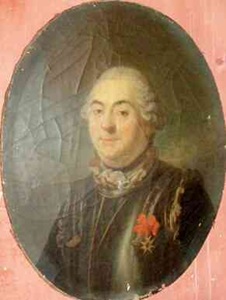 In the General Armorial of J. B. Rietstap, we find a single coat of arms of the Morange family: Azure with three cherubs of silver. It is said that the family bearing this heraldic device originated from Lyon. In reality, there has never been a "family" bearing this name and displaying these devices, at least if we understand "family" to mean at least two generations. This armorial was granted to Bedien Morange (or Morangies), "French Theologian", born in Paris in 1638 and died in Lyon in 1703. He was the Vicar General of the Diocese of Lyon and left no descendants. For a historical account of his life, see Lyonnais dignes de memoire, II., 192. Revue du Lyonnais, V., 193. The Morangies family, as it was originally written, took its name from a domain in Languedoc, prior to 1444. The name was previously Molette, which was retained, the family being known as Molette de Morangies in the main line, and simply Morange in secondary branches. It was a very old family that first appeared in Languedoc and distinguished itself by its alliances and significant military services.
In the General Armorial of J. B. Rietstap, we find a single coat of arms of the Morange family: Azure with three cherubs of silver. It is said that the family bearing this heraldic device originated from Lyon. In reality, there has never been a "family" bearing this name and displaying these devices, at least if we understand "family" to mean at least two generations. This armorial was granted to Bedien Morange (or Morangies), "French Theologian", born in Paris in 1638 and died in Lyon in 1703. He was the Vicar General of the Diocese of Lyon and left no descendants. For a historical account of his life, see Lyonnais dignes de memoire, II., 192. Revue du Lyonnais, V., 193. The Morangies family, as it was originally written, took its name from a domain in Languedoc, prior to 1444. The name was previously Molette, which was retained, the family being known as Molette de Morangies in the main line, and simply Morange in secondary branches. It was a very old family that first appeared in Languedoc and distinguished itself by its alliances and significant military services.
Before the Revolution, Languedoc was one of the largest and most important provinces in France. It was bordered to the north by Lyonnais and Auvergne, and by Rouergue and Quercy, subdivisions of Guyenne; to the east by the Rhone, which separated it from Dauphine and Provence; to the south by the Mediterranean, the province of Roussillon and the Pyrenees; and to the west by Guyenne and Gascony.
The family appears for the first time in 1237, when we discover that a certain Bertrand de Molette owned, in January of that year, certain lands of Raimond de la Garde, in Languedoc. Bertrand de Molette also obtained, in March 1248, a "noble fief" from Guillaume Blanc and Agnes, his wife. In May 1258, he received another "noble fief" from Barthelemi and Guillaume Merle. That same year, he occupied the castle of La Garde-Guerin.
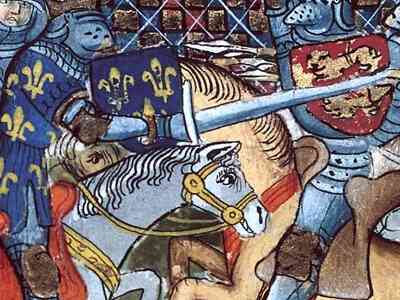 On May 17, 1264, Bertrand received from Guion Chanier, notary, Bertrand de Peyrenal, Bernard de Magotes, Bertrand de Molette, "co-lords" (co-lords of a manor) of La Garde-Guerin and of Hugen de Garde-Moyenne, prior of Prevencheres, certain lands in Languedoc. His son Barthelemi de Molette obtained, on November 12, 1293, additional lands at La Garde from Thomas de la Garde. He sold, on January 10, 1310, to Helix de Planchamps, widow of Guillaume de Beauvoir, a portion and lands of La Garde, sale ratified by Catherine, his wife, and by Jean and Bertrand, their sons. Among these sons, Bertrand de Molette held the title of "knight" and co-lord of La Garde-Guerin. In his will, dated December 18, 1330, he mentions his son Jean de Molette, lord of La Garde-Guerin. On September 5, 1392, he acquired considerable property through Agnes de Chateauneuf, who was probably a relative. Jean married, by contract dated July 5, 1395, Jeanne de Peyrebasse, daughter of the noble Raimond de Peyrebasse.
On May 17, 1264, Bertrand received from Guion Chanier, notary, Bertrand de Peyrenal, Bernard de Magotes, Bertrand de Molette, "co-lords" (co-lords of a manor) of La Garde-Guerin and of Hugen de Garde-Moyenne, prior of Prevencheres, certain lands in Languedoc. His son Barthelemi de Molette obtained, on November 12, 1293, additional lands at La Garde from Thomas de la Garde. He sold, on January 10, 1310, to Helix de Planchamps, widow of Guillaume de Beauvoir, a portion and lands of La Garde, sale ratified by Catherine, his wife, and by Jean and Bertrand, their sons. Among these sons, Bertrand de Molette held the title of "knight" and co-lord of La Garde-Guerin. In his will, dated December 18, 1330, he mentions his son Jean de Molette, lord of La Garde-Guerin. On September 5, 1392, he acquired considerable property through Agnes de Chateauneuf, who was probably a relative. Jean married, by contract dated July 5, 1395, Jeanne de Peyrebasse, daughter of the noble Raimond de Peyrebasse.
The Peyrebasse family originated from Guyenne, which borders Languedoc, and bore arms: "Of gules a silver band charged with a black cricket." Jean wrote his will on August 13, 1425, in which he mentions his children: Jean, whom we will discuss shortly, Claude, Leons, who married Armand Firmin, Amaradge, who married Jean de Fontaine, and Miracle, who married the Lord of Monteil des Vaus. Raimond and Philippe also played important roles in the family, with the name Morangies appearing for the first time.
Jean de Molette, knight, Lord of Morangies, co-lord of La Garde, married, by contract, on December 31, 1444, to Helix de Grille, daughter of Bertrand de Grille, from the diocese of Saint Fleur. The Grille family from Languedoc bore arms: "Of gules a silver band charged with a black cricket." They were ennobled as marquises in April 1684. It is unclear from whom Jean de Molette inherited the property of Morangies, but since the Peyrebasse family owned a place called Morangies, it is easy to conclude that he obtained these lands from his mother, Jeanne de Peyrebasse. Jean de Morangies wrote his will on November 4, 1466, and a codicil on February 7, 1477, in which he mentions his children: Azias, whom we will talk about shortly, Claude, Guigon, Jean, prior of Guillostre, Claude, who married Antoine Falcon, Delphine, who married Gilbert de Malbac, lord of Briges, Jeanne, who married Jean de Pierre, lord of the house of Bernis, and ancestor of this lineage, Catherine, abbess of Saint Gernieux.
Louis, lord of Morangies, co-owner of La Garde-Guerin, etc., in his will dated May 25, 1546, mentions his children: Claude. Charles, lord of Felgerolles. Gui, destined for the church. Louise. Gabrielle. Anne. Marguerite, who married Jacques d’Isar of Villefort in 1556.
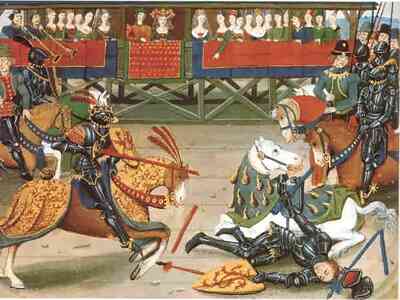 Claude, lord of Morangies, ambassador of Henry II, king of France, was appointed on February 16, 1563, by Charles IX, master of the stables, a very high position at the time, and received the Order of Saint Michael in July 1572. He married by contract on June 10, 1555, Françoise Guinoard, daughter of Claude de Guinoard, lord and baron of Reure, Grisac, Banc, Saint Florens, etc., and Florette des Poredets-de-Maillanc. In his will dated September 11, 1576, he mentions his children: Antoine. Charles. Jean-Antoine. Baltuzard, who was knighted and received the Order of Saint John of Jerusalem in 1579 (Templars?). François, lord of Ombret, of Recour, etc. He wrote his will on May 9, 1655, in which he mentions his children: Charles, of Plagnac. Antoine, of Provenchises (probably Prevencheres). Hugues. François. Françoise, who married Louis de Cubieres, lord of Cheylar and Pousilbac. Gabrielle, who married Henry (or Henri?) de la Garde. Anne.
Claude, lord of Morangies, ambassador of Henry II, king of France, was appointed on February 16, 1563, by Charles IX, master of the stables, a very high position at the time, and received the Order of Saint Michael in July 1572. He married by contract on June 10, 1555, Françoise Guinoard, daughter of Claude de Guinoard, lord and baron of Reure, Grisac, Banc, Saint Florens, etc., and Florette des Poredets-de-Maillanc. In his will dated September 11, 1576, he mentions his children: Antoine. Charles. Jean-Antoine. Baltuzard, who was knighted and received the Order of Saint John of Jerusalem in 1579 (Templars?). François, lord of Ombret, of Recour, etc. He wrote his will on May 9, 1655, in which he mentions his children: Charles, of Plagnac. Antoine, of Provenchises (probably Prevencheres). Hugues. François. Françoise, who married Louis de Cubieres, lord of Cheylar and Pousilbac. Gabrielle, who married Henry (or Henri?) de la Garde. Anne.
 Antoine married by contract on February 9, 1571, to Marie de Naves, daughter of Claude de Naves, lord of Mirandol. He wrote his will on May 25, 1586, mentioning his children: François, whom we will discuss shortly, and Charles. The Naves family obtained a coat of arms on January 15, 1647: "D’azur à une fasce ondee d’argent." François, the eldest son, lord of Morangies of La Garde-Guerin, seneschal of Alteyrne, Veilles-Passis, Baume, co-owner of Villefort and marquis of Morangies, was the first chamberlain of Monseigneur, the brother of King Louis XIII, on January 8, 1631. He was also a tutor to the royal children from July 23, 1634. He married by contract Marie de Louet de Colvisson on February 19, 1608, and wrote his will on December 9, 1636, in which he mentioned his children: Charles, whom we will discuss shortly, Marie, who married Nicolas de Chantel, lord of Contras (located a few kilometers northwest of Bordeaux), Françoise, a nun, Jeanne, a nun, and Gabrielle, who married François d’Alboy in 1640.
Antoine married by contract on February 9, 1571, to Marie de Naves, daughter of Claude de Naves, lord of Mirandol. He wrote his will on May 25, 1586, mentioning his children: François, whom we will discuss shortly, and Charles. The Naves family obtained a coat of arms on January 15, 1647: "D’azur à une fasce ondee d’argent." François, the eldest son, lord of Morangies of La Garde-Guerin, seneschal of Alteyrne, Veilles-Passis, Baume, co-owner of Villefort and marquis of Morangies, was the first chamberlain of Monseigneur, the brother of King Louis XIII, on January 8, 1631. He was also a tutor to the royal children from July 23, 1634. He married by contract Marie de Louet de Colvisson on February 19, 1608, and wrote his will on December 9, 1636, in which he mentioned his children: Charles, whom we will discuss shortly, Marie, who married Nicolas de Chantel, lord of Contras (located a few kilometers northwest of Bordeaux), Françoise, a nun, Jeanne, a nun, and Gabrielle, who married François d’Alboy in 1640.
Charles, Baron of Morangies, received a commission from King Louis XIV on May 26, 1651, to form a cavalry company. He received two letters, one from His Majesty on October 28, 1652, and the other from Monseigneur, the king’s uncle, on October 29, to join the army in Italy with his company. He was breveted by a royal edict on July 4, 1665, as bailli of Gevaudan and governor of the city of Marvejols. On June 21, 1639, he married Marguerite Felice de Montmorency by contract and wrote his will on August 2, 1682, mentioning his children: Charles. Scipion, who died in Dunkirk as lieutenant colonel of a regiment of Allnis. Jacques Louis, who accompanied the Prince of Conti and died without descendants. Annet, knight of Malta, commander of the Order of Saint-Felix, died as governor of Orange. François, abbot of Morangies and prior of Prevencheres. Joseph. Hyacinthe, abbot of Pylaumes.
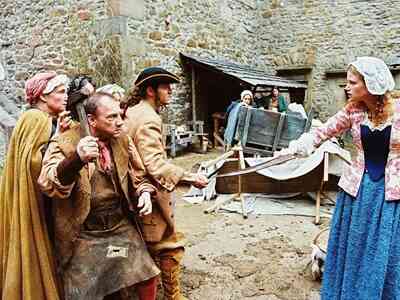 Charles, Count of Morangies, Marquis of St. Alban, Baron of La Garde-Guerin, lord of Pylaumes, etc., served in Hungary under Marshal de Coligny, before returning to France in 1664. He was Governor of Marvejols from 1677 to 1681. By contract, he married Catherine de la Fare on January 10, 1668, daughter of Charles de la Fare-Laujere, Marquis of Montelar and Lieutenant General of the Royal Army, also Governor of Roses. In his will of 1714, he mentioned only one son: Charles-Auguste, Colonel in a regiment bearing his name, knight of the Royal and Military Order of Saint-Louis, and Brigadier-General in the army. Charles-Auguste met his death in 1705 during the siege of Chives (or Chivas?) in Italy, at the age of 30. He married Françoise de Chateauneuf by contract on February 5, 1703, and had two children: Pierre Charles, whom we will discuss immediately, and Marie Charlotte, a nun at the Panthemost convent in Paris.
Charles, Count of Morangies, Marquis of St. Alban, Baron of La Garde-Guerin, lord of Pylaumes, etc., served in Hungary under Marshal de Coligny, before returning to France in 1664. He was Governor of Marvejols from 1677 to 1681. By contract, he married Catherine de la Fare on January 10, 1668, daughter of Charles de la Fare-Laujere, Marquis of Montelar and Lieutenant General of the Royal Army, also Governor of Roses. In his will of 1714, he mentioned only one son: Charles-Auguste, Colonel in a regiment bearing his name, knight of the Royal and Military Order of Saint-Louis, and Brigadier-General in the army. Charles-Auguste met his death in 1705 during the siege of Chives (or Chivas?) in Italy, at the age of 30. He married Françoise de Chateauneuf by contract on February 5, 1703, and had two children: Pierre Charles, whom we will discuss immediately, and Marie Charlotte, a nun at the Panthemost convent in Paris.
Pierre-Charles de Morange, Marquis of St. Alban, Baron of La Garde-Guerin, Count of Morangies, successively held the ranks of captain, sub-lieutenant, and lieutenant-general of the Royal Army. By contract, he married Louise Claudine de Chateauneuf-de-Randon on December 31, 1726, daughter of Jacques Thimotes de Guerin de Chateauneuf-de-Randon. Their union produced Jean François Charles, colonel of a regiment, who married Marie Therese de Beauvilliere de St. Aignana and had a son: François Paul, who died as captain of an infantry regiment, after marrying Charlotte d’Aignon des Hubas and fathering François Hyppolite (or Hypolite) Charles, Count of Morangies. The latter married Adelaide l’Anglade du Cheyla de Montgros in 1806.
 Jean Anne, Viscount of Morangies and St. Alban, was Marshal of the Royal Army, colonel of a regiment, and commander-in-chief of the national guards of Languedoc. He was also a knight of the Royal and Military Order of Saint-Louis. On January 31, 1781, he married Margaret Therese de la Vaysiere de Cantoinet and had a son: Jean Adam Guillaume-Gustave, born in Languedoc on April 10, 1791. He married on July 18, 1813, Albertine Marie Zoe, daughter of Antoine Bonne, Marquis of Regnauld de Parcieu, counselor to the French ambassador at the Court of Vienna, and had a son: Adam François, born in November 1815. Jean Adam, along with Alexandre, Grand Vicar of Auxerre, and Michaëlle, who died without descendants, complete this noble lineage.
Jean Anne, Viscount of Morangies and St. Alban, was Marshal of the Royal Army, colonel of a regiment, and commander-in-chief of the national guards of Languedoc. He was also a knight of the Royal and Military Order of Saint-Louis. On January 31, 1781, he married Margaret Therese de la Vaysiere de Cantoinet and had a son: Jean Adam Guillaume-Gustave, born in Languedoc on April 10, 1791. He married on July 18, 1813, Albertine Marie Zoe, daughter of Antoine Bonne, Marquis of Regnauld de Parcieu, counselor to the French ambassador at the Court of Vienna, and had a son: Adam François, born in November 1815. Jean Adam, along with Alexandre, Grand Vicar of Auxerre, and Michaëlle, who died without descendants, complete this noble lineage.
 Once upon a time, in the Middle Ages, there was a small hamlet simply called "La Garde." Travelers and merchants used the Regordane Way (GR700), linking the Massif Central to the Mediterranean. This path, once known as the "Estrade," was vital for trade and exchanges between the interior lands and the coast.
Once upon a time, in the Middle Ages, there was a small hamlet simply called "La Garde." Travelers and merchants used the Regordane Way (GR700), linking the Massif Central to the Mediterranean. This path, once known as the "Estrade," was vital for trade and exchanges between the interior lands and the coast.
At the request of the Bishop of Mende, La Garde became a strategic border post. A garrison of knights was tasked with protecting travelers and goods on the Regordane. Their mission: to ensure safety and smooth exchanges. In the 13th century, the name "Guerin" was added to the village's name, and La Garde became "La Garde-Guerin." The knights of La Garde-Guerin formed an economic and military community. They swore an oath to the Bishop of Mende and shared responsibilities: tolls, guiding travelers, protecting animals and goods. Each knight owned a "parerie" (or portion) of the Regordane path, which he maintained with care.
At the heart of the village stood the majestic medieval tower. Standing at 21.50 meters, it dominated the surroundings. Its unique rusticated stonework in the region testified to its importance. At its feet, the remains of the lordly residence reminded of the power of the noble consuls of La Garde-Guerin. The clans of "Gaucelmes," "Herail," "Bertrand," and "Gaules" would gather to maintain peace and decide on statutes. They were the guardians of this historic place, where the echoes of horses and merchants still resonated in the cobbled streets.
Today, La Garde-Guerin continues to watch over the Chassezac, like a sentinel of the past. Its ramparts tell the exploits of the knights, and the tower jealously guards the secrets of its medieval donjon. And if you stroll through its streets, perhaps you will still hear the whispers of travelers of yore, carrying their hopes and goods along the Regordane.
Former holiday hotel with a garden along the Allier, L'Etoile Guest House is located in La Bastide-Puylaurent between Lozere, Ardeche, and the Cevennes in the mountains of Southern France. At the crossroads of GR®7, GR®70 Stevenson Path, GR®72, GR®700 Regordane Way, GR®470 Allier River springs and gorges, GRP® Cevenol, Ardechoise Mountains, Margeride. Numerous loop trails for hiking and one-day biking excursions. Ideal for a relaxing and hiking getaway.
Copyright©etoile.fr